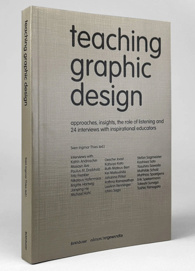Book Review
“teachers tend to listen less often”
Sven Ingmar Thies writes on a teching introspective
A journey. A career is a journey that leaves its mark on each if us. Teaching is a journey for the teacher and the student. Both aspects can be clearly felt in Sven Ingmar Thies’ book “teaching graphic design, approaches, insights, the role of listening and 24 interviews with inspirational educators.” One feels his journey through his career as a student in Germany and England (London), then as a practitioner for large branding agencies in London, and finally as an academic in Japan and Vienna. Along the way the author was formed and picked up friends, colleagues and acquaintances which are now interview partners. The journey—just as the list of interviewees—is impressive, international, cross-disciplinary and high caliber.
The book is structured into four sections. The first section sets the scene and defines the term graphic design (which I thought was great choice, as it is also my favorite term for the field). Here Thies defends this position in his balanced fashion: “Due to this continuous expansion, the wish to rename graphic design has come up again and again, which seems understandable at first. After all a new term seeks to capture and reflect the latest developments. At the same time, however, it seems a bit like inventing new professional titles so that every single employee has an individual position to show on their business card. … Why insist on new nomenclature when technological change gives rise to new media and forms of communication, but the substance remains the same?” (p. 23) The next section elaborates the author’s point of view on teaching, the third section—interviews—is by far the largest (taking up two-thirds of the book) and richest section in the book. The fourth part of the book is a small collection of sample assignments.
Thies’ obviously winning personality shows in the long list of interviews, in his enthusiasm and openness on the subject of teaching, and also through his portrait on page two. His love of listening or perhaps for dialogue is prevalent in the linguistic style of the book. Many parts of the book are structured like a conversation between the author and himself. For example: “Is there any action that teachers tend to employ less consciously? Is it the asking, listening, speaking, rethinking or letting a person do something? My experience from observations and conversations with teachers and students is that teachers tend to listen less often.” (p. 50) This is a clear strength of the book, the attitude of I am curious, and have a lot to learn, is ever present and challenges one to reflect on their own teaching. The author breaks teaching down to the nitty-gritty from: punctuality, formats, assessment, feedback, and the ever-present listening. By unpacking teaching into smaller parts, Thies gives the reader an opportunity to reflect bit by bit on their own teaching methods and habits. It would be desirable if there was a column for taking notes as you read.
The collection of assignments are also excellent, as they provide a different view into the teaching style of their originators. Obviously there are books which have larger collections of assignments (for example: Teaching Graphic Design, Course Offerings and Class Projects from the Leading Undergraduate and Graduate Programs, Steven Heller, ed., 2003; The Education of a Graphic Designer, Steven Heller, ed., 1998) but they provide an excellent contrast to the conversations or interviews, and round out the book a whole. The interviews are the best part of the book, a great collection of design educators with very different backgrounds, disciplines and strengths. Thies lets them speak, and encourages them to talk about their teaching philosophy, successes and failures. The alphabetical order keeps the mix colorful and interesting, and also hides how clearly the people connect to his own journey.
Unfortunately, the book also has weaknesses. As a native speaker, I felt that the language was sometimes a bit wooden, and would have encouraged a more idiomatic translation style. Make no mistake, translation is difficult even in the best of times. Here we have people from very different cultures, making it harder to get the style and the cultural nuances right. And although it is not a book about book design, the book is design-wise disappointing, and the cover feels downright nasty. This surprised me the most. Here is an author with an illustrious career, a member of one of the greatest design universities in Europe (that is not lacking in funds or talent), the design should have been spectacular. Compare it to Adrian Shaughnessy’s “How to be a Graphic Designer Without Loosing Your Soul” or Michael Bierut’s “79 Short Essays on Design” and it is found wanting. Finally—and this is a minor point—I would have enjoyed a reflection by the author on the interviews, and what he took away from them at the end of the book.
In the final analysis, the contents out weigh the formal negatives. Thies’ book on teaching graphic design has a lot to offer many design educators, in terms of inspiration, opportunities for reflection, and the ever so important journey outside of one’s own bubble.

